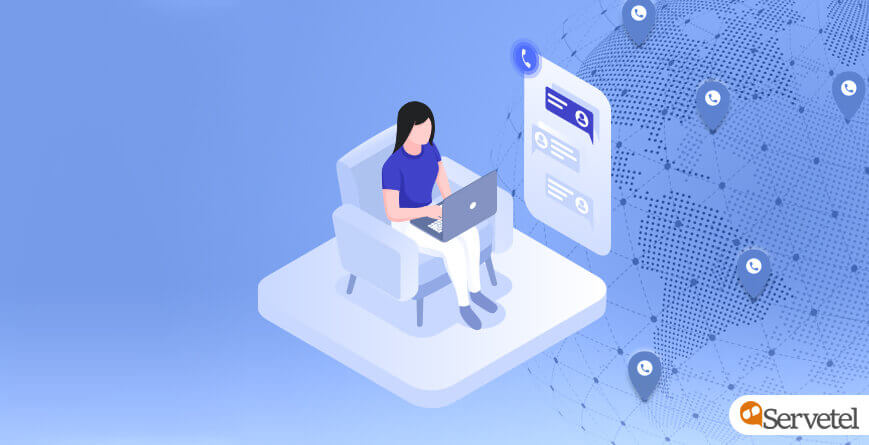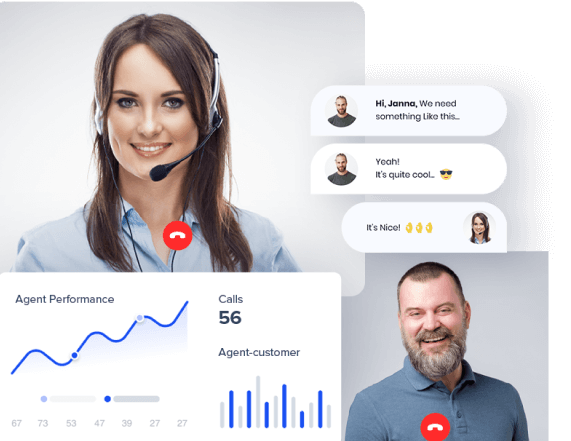You probably recall hearing the term ‘call center’ from before you first heard the term ‘contact center’. We don’t blame you—both are often used interchangeably. However, cloud contact center software not only evolve from call centers, but reimagine customer service and outbound sales.
At their core, call centers deal with customer queries via calls, while contact centers use multiple channels such as voice, text, email, and video to do the same. But there is more to this differentiation than the latter’s ability to go beyond voice calling—in today’s time, customer success can is highly dependent on having a multi-channel presence; in other words, you must be everywhere your customer is.
Hence, with this article, we aim to not only highlight the differences between contact vs call center but also tell you why contact centers are irreplaceable in today’s times, and call centers are—for a lack of a better term—redundant.
First, let’s understand how Contact Centers vs Call Centers operate.
What is a call center?
Gartner states, “A call center is a group or department where employees receive and make high volumes of telephone calls. They can have internal customers or external customers.” In functional terms, these departments present employees with a helpdesk and callers with a helpline.
Agents addressing customer queries via incoming calls from an inbound call center, and those engaging with sales activities form an outbound call center, often utilizing an outbound dialing system to streamline their processes. Depending on its size, a call center can be strictly inbound, outbound, or hybrid. A hybrid call center sees agents attend incoming as well as outgoing calls daily.
Apart from their function, there is another factor that helps classify call centers better—their location.
In-house Call Center Software
These are on-premises departments where agents sit together with dedicated hardware and software to handle customer calls.
Virtual call centers
Virtual call centers have agents working from remote locations with the help of an internet-enabled device and calling software.
What is a contact center?
Cloud contact center, as mentioned above, are the evolved versions of call centers that operate over multiple channels. They also offer many more features and assure high customizability.
They work on the latest VoIP or Voice-over Internet Protocol technology. As the name suggests, VoIP allows you to make calls over the Internet. Learn more about best VoIP systems in this guide.
While calling remains a significant communication platform for customers, contact centers also include other mediums such as SMS, chat, video, and emails, often on a unified platform. This aspect makes contact centers more suitable for customer services. However, you can still use them for sales and technical support. According to Time Doctor, an increasing number of people prefer using multiple channels such as social media, email, calls, and chat to communicate with brands.
Like their predecessors, contact centers can be classified into different groups such as inbound contact center, outbound contact center, hybrid, in-house and virtual.
Despite these centers being feature-rich and technologically advanced, their digital nature makes them cheaper to build and maintain for providers and cost you much less to deploy.
If you want to read more about how call centers evolved into modern-day contact centers, you can find it in our Complete Guide to Contact Centers and Running Them Successfully.
Contact Center vs Call Center: Key differences
| Aspect | Call Center | Contact Center |
| Communication | Voice | Omnichannel |
| Approach | Reactive | Proactive |
| Technology | Traditional | Cloud-based |
| Automation | Limited | Advanced |
| Scalability | Fixed | Flexible |
| Data Insights | Basic | Advanced |
| Support | Single channel | Multichannel |
| Infrastructure | On-premises | Cloud-based |
| Reporting | Manual | AI-driven |
| Customer Experience | Standard | Personalized |
Now that we’ve briefly discussed their similarities and history, we can get down to the main agenda of this blog—how contact centers are better than call centers. To identify that, we look at their differences given below:
Narrow vs. in-depth customer data
Due to call centers being restricted to a single channel for customer interaction, the data they gather is limited. They may use speech analysis to understand the customer’s preferences and emotions, but it won’t be enough. Contact centers, however, provide omnichannel support and gather data from multiple platforms for a deeper understanding of the customer’s preferences.
Traditional vs VoIP calling
Traditional calling systems, which most call centers deploy, fall behind in providing top-notch calling experiences as compared to VoIP. The traditional system restricts calling to a single device (for instance, a landline), while VoIP calling lets you make calls from any device. All it takes is an active internet connection and a portal login.
Read this blog “VoIP Vs Landline” here.
Rigidity in features vs. customizability
Contact centers offer much more customizability than traditional call centers. Traditional communication systems are often limited because any modification requires expensive hardware changes. On the contrary, voip phone system offer many features that you can pick with a single click. For instance, at Acefone you can choose from 65+ customizable features that constantly update and witness additions.
You can also check out those Contact center software features on our website by clicking here.
Reactive vs. Proactive Customer Support
Call centers primarily operate reactively, meaning agents only respond when a customer calls in with a query or issue. This limits engagement opportunities and often leads to longer resolution times.
Contact centers, on the other hand, use automated follow-ups, and predictive analytics to engage customers proactively. You can send appointment reminders, follow up on abandoned carts, or notify customers about service upgrades—ensuring a smoother customer experience while reducing inbound call volume.
Limited vs. Omnichannel Communication
Call centers focus solely on voice-based interactions, restricting customer communication to phone calls. This can be inconvenient for customers who prefer messaging or digital platforms.
Contact centers provide omnichannel support, allowing customers to interact via email, SMS, live chat, social media, and video calls. This ensures customers can connect through their preferred channel and switch between platforms seamlessly while maintaining conversation history for a unified experience.
Manual vs. Automated Workflows
Traditional call centers rely heavily on manual operations, including call routing, agent assignments, and customer data entry. This can lead to inefficiencies and human errors.
Contact centers automate these processes with smart IVRs, chatbots, and intelligent call distribution. Automated workflows reduce agent workload, speed up resolutions, and enhance customer satisfaction. For instance, chatbots can handle common inquiries 24/7, while smart routing ensures customers connect with the right agent instantly.
Basic Reporting vs. Advanced Analytics
Call centers provide basic reports focused on call duration, call volume, and agent performance. While useful, these reports offer limited insights into customer behavior.
Contact centers leverage advanced analytics tools that track sentiment analysis, real-time customer interactions, and engagement patterns across multiple channels. Businesses can use these insights to personalize customer interactions, identify service bottlenecks, and improve overall customer experience.
On-Premises vs. Cloud-Based Infrastructure
Most traditional call centers operate on on-premises systems. This means that they require costly infrastructure, dedicated IT teams, and frequent hardware upgrades. This limits scalability and flexibility.
Contact centers are cloud-based, allowing businesses to scale operations effortlessly without investing in expensive hardware. Your team can work remotely with secure access to customer data, ensuring uninterrupted service even during disruptions. Cloud solutions also offer regular software updates, ensuring businesses always have access to the latest communication technologies.
Why are companies switching to contact center solutions?
Drew Kraus, the VP Analyst at Gartner Customer Service & Support, said, “Contact center as a service (CCaaS) is a growth market; The technology offers greater software agility with a tower cost of ownership, making it a key area of investment in innovation and customer service applications that surpasses the offers of legacy premises-based or server technology.”
Recent studies validate this. According to global statistics the Contact Center as a Service (CCaaS) market was valued at approximately USD 5,108.4 million in 2024. Projections indicate that it will expand from USD 5,799.06 million in 2025 to approximately USD 7,473.13 million by 2033, with an estimated compound annual growth rate (CAGR) of 13.52% over the 2025–2033 period.
If you’re still not convinced whether you should use Contact Centers vs Call Centers, here are a few benefits that will help you decide.
Cost-effective
Contact center solutions come at cost-effective rates compared to call center business pbx systems. To set up a contact center system, the only investment you need is a device and a VoIP-enabled calling solution. You save money on hardware installation, excessive hiring, and infrastructure maintenance.
Scalability
Any changes you wish to make to your calling solution can be made with a few clicks. If you need more extensions or user logins, you can simply ask your provider to include them in your subscription. You can add more agents to the system instantly if you experience a rapid increase in your daily calls.
Unified view
A key benefit of using a cloud contact center solution is that it gives you access to all data on one platform. The calling portal showcases customer information from multiple channels on one dashboard.
Future proof
Google says, “Moving to the cloud is giving organizations of all shapes and sizes the ability to move faster, be more agile, and innovate their businesses.” That’s true for cloud solutions of all sizes—any technological innovation in the cloud telephony space will be a part of your solution sooner rather than later. This way, always rest assured of better automation, productivity, and reliability.
Agent productivity
Contact center solutions make it easy for agents to deal with higher call volumes without getting overwhelmed and still provide meaningful solutions. With features such as call recording, call barging, call transferring, and live call monitoring, managers can supervise agents more efficiently and help them reach their goals faster.
Top 5 contact center features
VoIP offers endless features that enrich your contact center solutions. Therefore, we came up with a list of critical ones every contact center must have to function optimally.
IVR
An interactive voice response or IVR system is highly critical for inbound calling. It is a calling menu that lets the caller route themselves to the right agent by navigating through the given options. Any inbound contact center is incomplete without an IVR.
Call monitoring and supervision
Contact center solutions often provide both bird’s-eye and detailed live monitoring of calls and other channels. It is possible to view what agents are up to via a live dashboard, while call detail records or CDR help supervisors gauge an agent’s performance.
Similarly, features such as automatic call distribution (ACD), access management, ring groups, conference calling, and blind call monitoring help supervisors assist agents.
Integrations
Top contact centers solutions allow telephony integration with CRM and helpdesk tools, which helps teams deliver personalized experiences and manage customer information across platforms. You can integrate Acefone’s contact center solution with 20+ popular CRM integrations for better lead management.
Automated dialers
Automated dialers help your agents focus on the most important aspect of any business—customers. They reduce any time wasted on manually dialing numbers and switching between calls.
These dialers are programmed to identify genuine calls. They also monitor operator availability and route calls accordingly to minimize call-drop rates.
At Acefone, we offer two types of predictive dialers—ratio dialers and preview dialers. You can get in touch with our experts and to know more about them,
Calling analytics
Calling analytics provide detailed insights about the quality of service, average and max call waiting time, average handling time, and the average number of agents available. This helps stakeholders make informed decisions in alignment with the organization’s objectives.
The takeaway
While call centers focus on sales, contact centers are the go-to option for overall customer services as they provide better agent assistance and analyses.
Investing in a cloud contact center, however, is a wiser decision for overall productivity. You get an omnichannel solution for smoother communication with access to 75+ customizable and future-proof features. Scaling a contact center solution is also easier as it doesn’t require adding any expensive hardware. You can even add and remove agents from the dashboard with a few clicks. Thus, getting a contact center solution for your business can yield better ROI as compared to a call center solution and later upgrading it.
FAQs
A contact center solution enhances the customer journey by enabling seamless customer communication across multiple channels like email, social media, and chat. This is unlike traditional call centers that rely solely on phone calls. AI-driven tools and automation help contact center agents deliver faster, more personalized support, exceeding customer expectations. Yes, modern contact centers integrate with CRMs, ticketing platforms, and contact center software, allowing you to streamline customer interactions. These integrations ensure that contact center agents have real-time access to customer history, enabling personalized service and smoother customer journeys. An inbound call center equipped with an interactive voice response (IVR) system can automate routine queries, reducing agent workload. You can ensure outbound calls and support requests are assigned to the right contact center agents, improving response times and optimizing customer communication. Yes, when comparing a call center vs. contact center, the latter is often more cost-effective. A contact center solution operates on cloud-based infrastructure, eliminating hardware costs. Advanced automation reduces dependency on manual processes, allowing you to scale operations efficiently while meeting customer expectations. Cloud-based contact center software includes end-to-end encryption and compliance measures to protect sensitive data, such as debt collection records. This helps secure customer communication through encrypted email, social media, and phone calls. Yes, modern contact centers use advanced analytics to monitor real-time data on customer interactions. Unlike traditional call centers, a contact center solution provides insights into multiple channels, helping you understand customer journeys and adjust strategies to meet evolving customer expectations. With cloud-based contact center software, agents can work from anywhere with an internet connection. Secure logins and AI-driven workflows ensure that customer interactions remain seamless. Unlike traditional call center setups, which rely on on-site infrastructure, contact centers support remote collaboration effectively. With an interactive voice response (IVR) system, modern contact centers ensure that phone calls are routed to the most qualified agents. With advanced insights and centralized customer interactions, you can reduce transfers, resolve queries faster, and enhance customer expectations.














